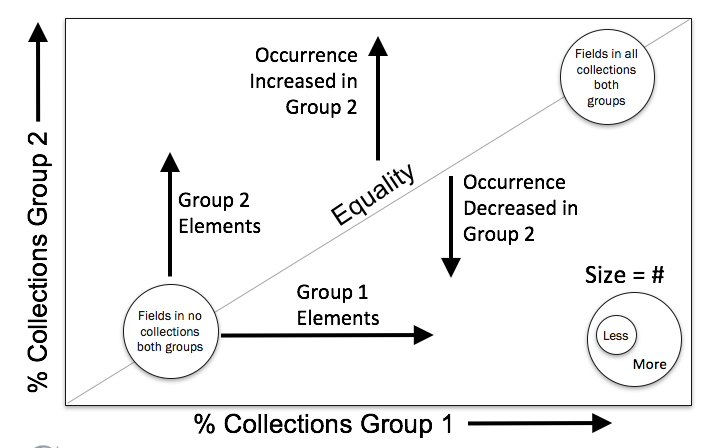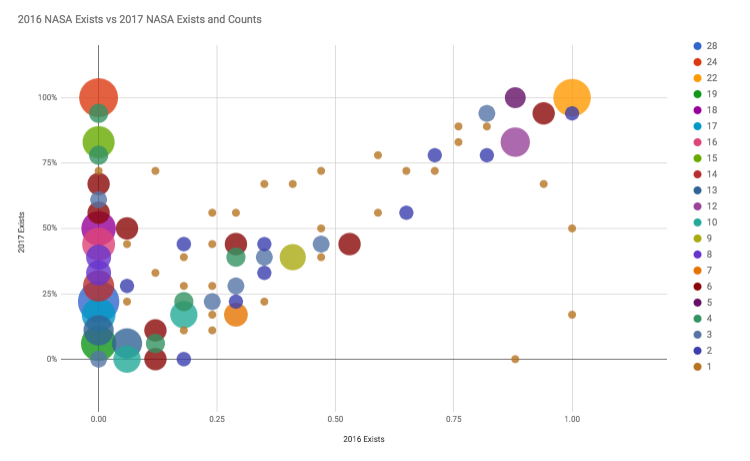Overview
The CMR includes metadata that originate in three dialects: DIF, ECHO, and ISO. The largest portion of CMR collection records are in the SciOps collection, and are inserted into the CMR in DIF format. The second largest portion of metadata for NASA collections originate from ECHO and are inserted into the CMR in ECHO format. These are referred to here as the NASA collection. A third group of metadata in the CMR originate from other agencies around the world and are generally either in DIF or possibly in ISO. These are referred to as the Other collection. The focus of this evaluation is NASA metadata collections.
The purpose of this evaluation is compare the usage of elements in NASA 2016 metadata collections with NASA 2017 metadata collections in order to identify and visualize how NASA metadata collections are evolving over time.
Data Selection
The table below shows the collections included in this evaluation as well as the record count for each collection.
Table 1. Collections and record counts
Collection | Organization | 2016 Count | 2017 Count
|
ASF | NASA | 84 | 161 |
CDDIS | NASA | 28 | 38 |
GES_DISC | NASA | 35 | 1044 |
GHRC | NASA | 339 | 361 |
| GSFCS4PA | NASA | 687 | |
LAADS | NASA | 78 | 130 |
LANCEAMSR2 | NASA | 5 | 6 |
LANCEMODIS | NASA | 116 | 154 |
LARC | NASA | 343 | 406 |
LARC_ASDC | NASA | 495 | 606 |
LPDAAC_ECS | NASA | 185 | 285 |
NSIDC_ECS | NASA | 197 | 223 |
NSIDC_V0 | NASA | 784 | |
OB_DAAC | NASA | 63 | 132 |
OMNIRT | NASA | 4 | 5 |
ORNL_DAAC | NASA | 1135 | 1216 |
PODAAC | NASA | 375 | 603 |
SEDAC | NASA | 202 | |
USGS_EROS | NASA | 11 | 11 |
Note:
- GSFCS4PA 2016 records were moved to the GES_DISC collection in 2017
- NSIDC_V0 and SEDAC were not included in the 2016 analysis
NASA 2016 vs NASA 2017
This analysis compares element usage in 17 NASA 2016 collection with element usage in 18 2017 collections. This evaluation identifies elements which exist in collections. In order for an elements to exist in a collection it must be present in at least 1 metadata record included in the collection. Element usage for NASA 2016 collections and NASA 2017 collections is shown below using bubble charts. The bubble chart interpretation graphic provides a schematic for interpreting the bubble plots.
Bubble Chart Interpretation
NASA 2016 Exists vs NASA 2017 Exists
Chart 1 below compares element existence in 2016 NASA Collections with 2017 NASA collections. The X axis shows the percent of NASA 2016 collections that include an element. The Y axis shows the percent NASA 2017 collections that include an element. The bubble size shows the number of elements included in the 2 collections.
The large red bubble in the upper left corner of the plot shows elements that exist is 100 percent of NASA 2017 collections and 0 percent of NASA 2016 collections. This bubble includes 24 elements, as shown in the legend. The large yellow bubble in the upper right corner of the plot shows elements that exist is 100 percent of NASA 2016 and 100 percent of NASA 2017 collections. This bubble includes 22 elements, as shown in the legend. The data for Chart 1 is accessible in Google Sheets. To view the data and bubble chart in Google Sheets click on the image.
Chart 1: NASA 2016 EXIST vs NASA 2017 Exists
Accessing the Chart
To access the data for this chart, click on the chart graphic above to view an interactive version in Google Sheets. The interactive version enables data identification for each bubble and includes a look up table for identifying the ISO elements associated with the bubble. To access and use the interactive version:
- Click on the chart graphic above to view the chart in Google Sheets
- Hover over the bubbles with your mouse to identify the concept existence in 2017 NASA collections and concept existence in 2016 NASA collections associated with the bubble. The hover identification also shows the number of elements (Counts) associated with each bubble.
- To the right of the chart is a lookup table for identifying the xpaths associated with each of the bubbles. To identify the xpaths associated with a bubble, match the NASA Exists and Other Exists values from the bubble hover with the values in the look up table.
Elements in all NASA 2016 and NASA 2017 Collections
Twenty-two elements exist in all NASA 2016 collection and all NASA 2017 Collections. See the All 2016 and All 2017 filtered view to identify these elements.
Elements in all NASA 2016 Collections and some NASA 2017 Collections
Four elements exist in all NASA 2016 Collections and in a smaller number of NASA 2017 collections. See the All 2016 and Some 2017 filtered view to identify these elements.
Elements in some NASA 2016 Collections and all NASA 2017 Collections
Five elements exist in all NASA 2017 Collections and in a smaller number of NASA 2016 collections. See the All 2017 and Some 2016 filtered view to identify these elements.
Elements in some NASA 2016 Collections and No NASA 2017 Collections
Twenty-one elements exist in some NASA 2016 Collections and in no NASA 2017 collections. See the Some 2016 and None 2017 filtered view to identify these elements.
Elements in No NASA 2016 Collections and some NASA 2017 Collections
Forty-eight elements exist in some NASA 2017 Collections and in no NASA 2016 collections. See the Some 2017 and None 2016 filtered view to identify these elements.

